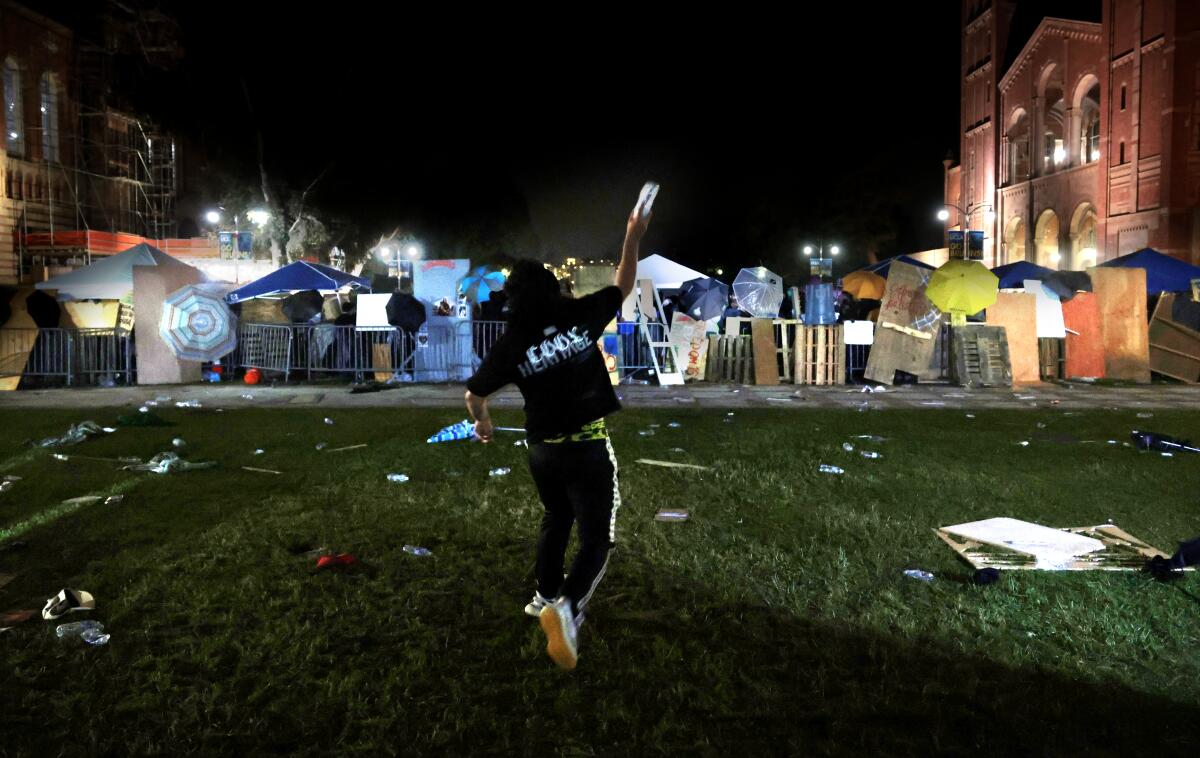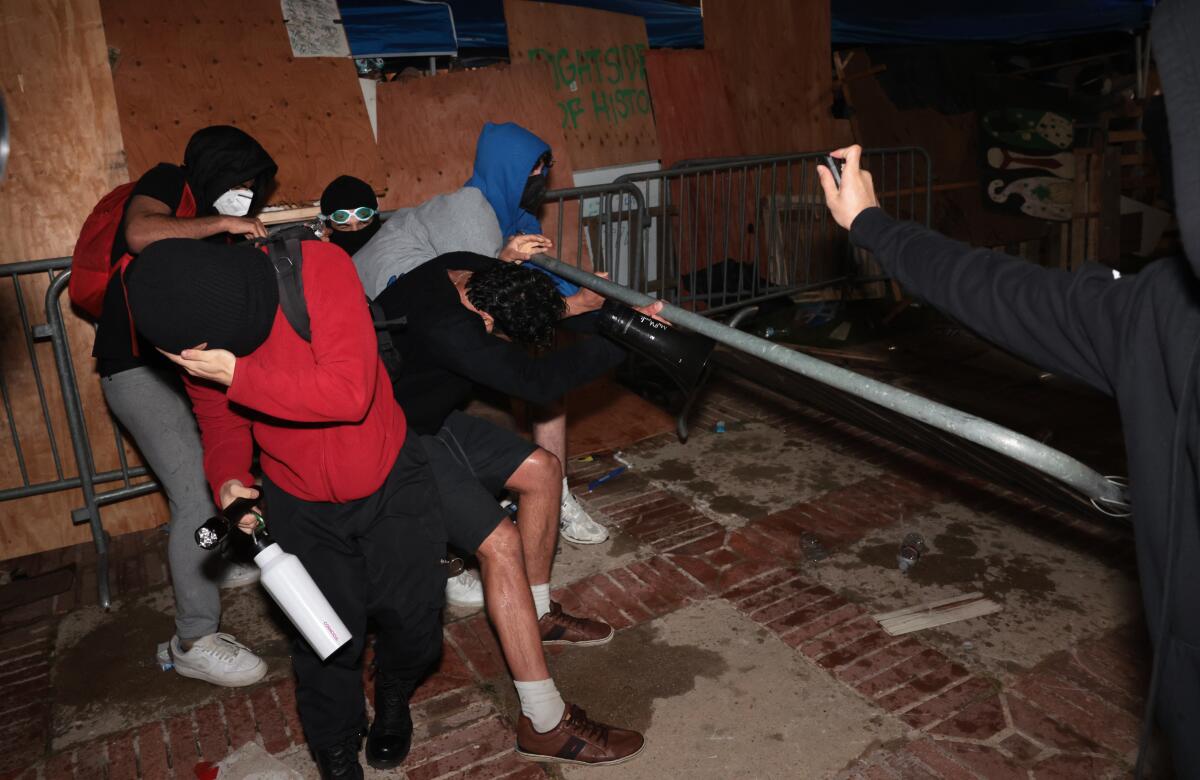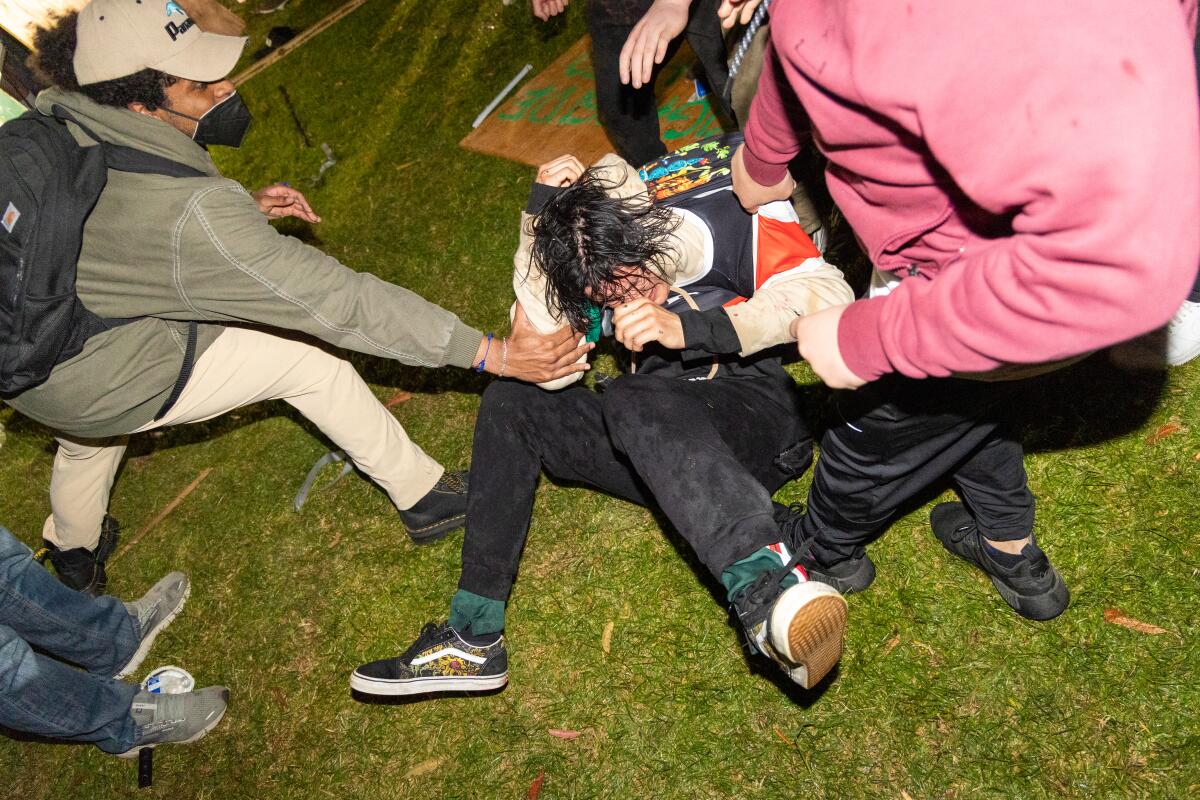Online detectives race to identify men who attacked UCLA camp

Online sleuths went to work hours after the violence broke out at UCLA this week.
They grabbed videos of the mostly masked rioters who attacked the pro-Palestinian student encampment near the quad and tried to zoom in on the faces. They pored over each image, waiting for the moment when masks slipped and faces were exposed to take screenshots. Then they uploaded these faces to X (formerly Twitter), Instagram, and other social media platforms and begged the Internet to do its job.
From across the country and around the world, people went online and joined the collective research effort.
Soon, the names of the alleged perpetrators, and in some cases identifying details such as places of employment, were published online along with photos. Car license plates belonging to suspected pro-Israel counter-protesters were also displayed.

A pro-Israel supporter throws a water bottle at the pro-Palestinian encampment at UCLA early Wednesday morning.
(Wally Skalij / Los Angeles)
Law enforcement officials, including the U.S. attorney’s office in Los Angeles, declined to comment on the tactic. But some who study extremism said the online efforts to identify and expose the alleged perpetrators of the UCLA violence are yet another sign of how polarized civil society is today: People don’t don’t trust the justice system to investigate or deliver justice, and they take it upon themselves.
“That’s where we are right now,” said Brian Levin, founding director of the Center for the Study of Hate and Extremism at Cal State San Bernardino. “People feel, for their own protection, they need to bring their own glasses (to protect themselves from tear gas at protests), and they also need to find their own attackers.”
He added: “Here’s the thing: Sometimes doxing is wrong. »
Doxing – the posting of a person’s name, address and other identifying data – has been around as long as people have been online. But the tactic gained prominence after the Unite the Right march in Charlottesville, Virginia, in 2017, when people collected the identities — sometimes falsely — of participants in the white nationalist rally.
Then came January 6, 2021, when thousands stormed the U.S. Capitol. A loosely organized group of online sleuths — known as “Sedition Hunters” – dedicated themselves to identifying them and passing their names to the FBI.

Pro-Palestinian protesters are crushed by a pro-Israel supporter at an encampment at UCLA early Wednesday morning.
(Wally Skalij / Los Angeles)
When a large group of men wearing black outfits and white masks burst into the UCLA encampment Tuesday evening, pro-Palestinian groups almost immediately began trying to identify them.
“Can anyone identify this man @UCLA?” a message read. “He hit an activist in the head with a wooden board, before punching and kicking another person. »
“If you recognize this man, send me a message. He pepper-sprayed me,” another Instagram post read.
“Identify this criminal,” another person posted on Instagram, above a photograph of a man in a black T-shirt with a red scarf momentarily pulled down to reveal his face. “The main culprit in the brutal assault on our allies at UCLA last night. *Note: Lawyers will deal with him once he is identified. Not us. All we need is his name.
Shortly afterward, the professional website of a Los Angeles man named as one of the attackers was flooded with angry reviews. Others identified rushed to make their social media profiles private, disabled comments on their business pages, and set their phones to send all calls to voicemail.
In some cases, online doxing was quickly followed by apologies for identifying the wrong person.
“Please disregard,” one person wrote on Instagram after saying a name. Another photograph was labeled with a few different names (without it being clear which name was the correct one).
The Times is not naming any of the people identified online. Journalists tried to contact several of them, but their messages went unanswered.
Despite the risks of sending an angry online mob after innocent people, some students at the camp said they felt they had no choice.
“We would like to protect ourselves by making these people known,” Nicolette, 26, said Wednesday inside the UCLA camp. She said she endured hours of terror as the men threw fireworks into the camp, pepper-sprayed them and threw objects, including live mice, at them.
Nicolette added that many pro-Palestinian students have also been doxxed, with their names posted on websites. For this reason – and to avoid repercussions from university officials – many students in pro-Palestinian encampments across the country have also been masked this week. And, like Nicolette, they refused to share their full names with reporters.
Jenna, a 21-year-old student at UCLA, said that before things escalated into violence, a group of about 10 people showed up, all wearing white masks, an action that she said, “was definitely coordinated.” Around 11 p.m., she said, black trucks arrived, older men got out and a huge crowd began moving toward the encampment.
Another woman, who called herself “Nicky” and had been at the camp since Thursday, said students took to group chats to share photos and identify some of those responsible.

A pro-Palestinian supporter was beaten by counter-protesters on the UCLA campus on May 1. Groups of dueling protesters clashed on campus, including fistfights, shoving, kicking and using sticks to beat each other.
(Trevor Jackson / For Time)
She said they made that decision in part because they didn’t expect police or campus authorities to search for and identify the counterprotesters.
“Here they allowed them to terrorize us all night and they did nothing,” she said. The 37-year-old said law enforcement, possibly California Highway Patrol officers, showed up briefly and “left like it was none of their business.”
In group discussions, people circulated the addresses and phone numbers of counterprotesters. In the case of a man waving a large yellow flag that read “Mashiach” – the Messiah – pro-Palestinians watched him walk to his car and were able to see what was on his numberplate. The man wore a black mask and shouted, “We fear no one but God.” The Army of God.
“We’re going to see what his license plate is, because we’re going to find out his identity tonight,” someone said in a video as they followed him to take a photo. “He thinks he’s safe, that no one will know who he is. This is why he was so bold.
Officials, including the UCLA and Los Angeles police departments, have said little about their efforts to identify and arrest the men who unleashed the violence against protesters at UCLA. Mayor Karen Bass, who rushed to Los Angeles when the violence broke out, said she was demanding a “thorough investigation.”
“Those who threw fireworks at others, sprayed chemicals and physically assaulted others will be found, arrested and prosecuted, as will anyone involved in any form of violence or lawlessness,” he said. -she declared in a press release.
Around the encampment, theories about who was responsible spread fast and furious. Some believed the counterprotesters were paid agitators. Others believed the melee was a crime of opportunity. The majority of pro-Palestinians insisted that the counter-protesters were not students.
Hussam Ayloush, executive director of the Council on American-Islamic Relations office in Los Angeles, called the agitators “pro-Israel extremists” and said CAIR lawyers “are exploring all legal avenues to hold the perpetrators accountable.” of these terrorist attacks.
Ayloush said CAIR is asking those who have been injured to contact its offices and submit reports and evidence, “so we can help take necessary action.”
Times staff writer Matthew Ormseth contributed to this report.
California Daily Newspapers





